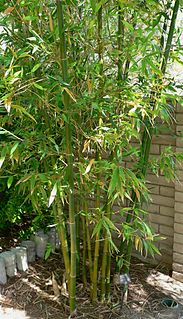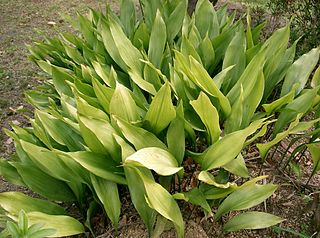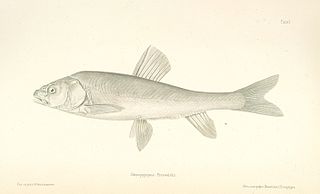
The giant panda, also known as the panda bear or simply the panda, is a bear native to south central China. It is characterised by large, black patches around its eyes, over the ears, and across its round body. The name "giant panda" is sometimes used to distinguish it from the red panda, a neighboring musteloid. Though it belongs to the order Carnivora, the giant panda is a folivore, with bamboo shoots and leaves making up more than 99% of its diet. Giant pandas in the wild will occasionally eat other grasses, wild tubers, or even meat in the form of birds, rodents, or carrion. In captivity, they may receive honey, eggs, fish, yams, shrub leaves, oranges, or bananas along with specially prepared food.

Bambusa is a large genus of clumping bamboos. Most species of Bambusa are rather large, with numerous branches emerging from the nodes, and one or two much larger than the rest. The branches can be as long as 11 m (35 ft).

Aspidistra is a genus of flowering plants in the family Asparagaceae, subfamily Nolinoideae, native to eastern and southeastern Asia, particularly China and Vietnam. They grow in shade under trees and shrubs. Their leaves arise more or less directly from ground level, where their flowers also appear. The number of species known has increased considerably from the 1980s onwards, with around 100 accepted as of July 2013. Aspidistra elatior is common worldwide as a foliage house plant that is very tolerant of neglect. It and other species can also be grown in shade outside, where they are generally hardy to −5 °C (23 °F).

Acrossocheilus is a genus of ray-finned fishes in the family Cyprinidae, native to freshwater in China, Taiwan, Laos, and Vietnam. They are fairly small, no more than 30 cm (1 ft) in standard length.

Crassostrea is a genus of true oysters containing some of the most important oysters used for food. Some species in the genus have been moved to the genus Magallana.

Pseudosasa is a genus of East Asian bamboo in the grass family.

Sinobambusa is a genus of East Asian bamboo in the grass family. It is native to China and Vietnam. Sinobambusa tootsik also occurs in Japan, having been introduced there during the Tang Dynasty (618–907).
- Sinobambusa baccanensisT.Q.Nguyen – Vietnam
- Sinobambusa farinosa(McClure) T.H.Wen – Fujian, Guangdong, Guangxi, Jiangxi, Zhejiang
- Sinobambusa henryi(McClure) C.D.Chu & C.S.Chao – Guangdong, Guangxi
- Sinobambusa humilaMcClure – Guangdong
- Sinobambusa incanaT.H.Wen – Guangdong
- Sinobambusa intermediaMcClure – Fujian, Guangdong, Guangxi, Sichuan, Yunnan
- Sinobambusa nephroauritaC.D.Chu & C.S.Chao – Guangdong, Guangxi, Sichuan
- Sinobambusa rubroligulaMcClure – Guangdong, Guangxi, Hainan
- Sinobambusa sat(Balansa) C.S.Chao & Renvoize – Vietnam
- Sinobambusa scabridaT.H.Wen – Guangxi
- Sinobambusa solearis(McClure) T.Q.Nguyen – Vietnam
- Sinobambusa tootsik(Makino) Makino ex Nakai – Fujian, Guangdong, Guangxi, Vietnam; naturalized in Japan including Ryukyu Islands
- Sinobambusa yixingensisC.S.Chao & K.S.Xiao – Jiangsu

Cymbidium, commonly known as boat orchids, is a genus of evergreen flowering plants in the orchid family Orchidaceae. Orchids in this genus are epiphytic, lithophytic, terrestrial or rarely leafless saprophytic herbs usually with pseudobulbs. There are usually between three and twelve leaves arranged in two ranks on each pseudobulb or shoot and lasting for several years. From one to a large number of flowers are arranged on an unbranched flowering stem arising from the base of the pseudobulb. The sepals and petals are all free from and similar to each other. The labellum is significantly different from the other petals and the sepals and has three lobes. There are about fifty-five species and sixteen further natural hybrids occurring in the wild from tropical and subtropical Asia to Australia. Cymbidiums are well known in horticulture and many cultivars have been developed.

The Panax (ginseng) genus belongs to the Araliaceae (ivy) family. Panax species are characterized by the presence of ginsenosides and gintonin. Panax is one of approximately 60 plant genera with a classical disjunct east Asian and east North American distribution. Furthermore, this disjunct distribution is asymmetric as only two of the ~18 species in genus are native to North America.

Yushania is a genus of bamboo in the grass family.
Neomicrocalamus is an Asian genus of bamboo in the grass family.
Sinocyclocheilus is a genus of freshwater fish in the family Cyprinidae endemic to China, where only found in Guangxi, Guizhou and Yunnan. Almost all of its species live in or around caves and most of these have adaptions typical of cavefish such as a lack of scales, lack of pigmentation and reduced eyes. Several species have an unusual hunchbacked appearance and some of the cave-dwellers have a "horn" on the back, the function of which is unclear. In contrast, the Sinocyclocheilus species that live aboveground, as well as a few found underground, show no clear cavefish adaptions. They are relatively small fish reaching up to 23 cm (9.1 in) in length. The individual species have small ranges and populations, leading to the status of most of the evaluated species as threatened. Many species populations in the genus have yet to be evaluated by the IUCN.

Oreonectes is a genus of fish in the family Nemacheilidae found in the rivers and cave of Asia. Many of these species are troglobitic.

Triplophysa is a genus of fish in the family Nemacheilidae found mainly in and around the Qinghai-Tibet Plateau in China. Currently, the genus is a mixed assemblage of species. Some lineages have been identified and treated as subgenera, but as Wikipedia follows Fishbase for fish species these have been treated as subgenera in Wikipedia, although Kottelat and the Catalog of Fishes treat them as genera. FishBase, however, includes these in Triplophysa without specifying subgenera and treats the names given by Kottelat as synonyms.

Gastrochilus, abbreviated Gchls in horticultural trade, is a genus of plant in family Orchidaceae. It is native to eastern and southeastern Asia, including China, Japan, Bangladesh, Thailand, Malaysia, Indonesia, the Philippines, etc.

Gastrodia, commonly known as potato orchids or as 天麻属 , is a genus of terrestrial leafless orchids in the family Orchidaceae, about ninety of which have been described. Orchids in this genus have fleshy, upright stems and small to medium-sized resupinate flowers with narrow sepals and petals. They are native to Asia, Australia, New Zealand, central Africa, and various islands of the Indian and Pacific Oceans.

Gymnocypris is a genus of fish in the family Cyprinidae endemic to China.
Bashania is a genus of East Asian bamboo in the grass family, native to China and Vietnam.
- Bashania abietinaT.P.Yi & L.Yang – Sichuan
- Bashania fansipanensisT.Q.Nguyen – Vietnam
- Bashania fargesii(E.G.Camus) Keng f. & T.P.Yi – Gansu, Hubei, Shaanxi, Sichuan
- Bashania qingchengshanensisKeng f. & T.P.Yi – Sichuan
Bambusa basihirsuta is a species of Bambusa bamboo.
Bambusa beecheyana is a species of Bambusa bamboo.














